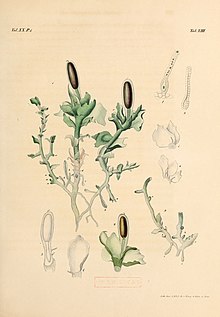Haplomitriopsida
| Haplomitriopsida Temporal range:
| |
|---|---|

| |
| Haplomitrium hookeri | |
| Scientific classification | |
| Kingdom: | Plantae |
| Division: | Marchantiophyta |
| Class: | Haplomitriopsida Stotler & Stotl.-Crand. |
| Subgroups | |
| Synonyms | |
|
Treubiopsida M.Stech, J.-P.Frahm, Hilger & W.Frey | |
Haplomitriopsida is a newly recognized
Description
Plants of
Haplomitrium has a number of unique characters that distinguish it from other liverworts, such as lacking rhizoids. The vegetative stems possess a central
Treubia also has features that differ from those found in other bryophytes,[8] such as the differentiation of five identifiable zones in the stem midrib. Unlike other leafy species, the oil bodies in its cells are restricted to certain clusters of cells, as they are in the Marchantiopsida. These oil body clusters appear as dark spots in the leaves when the plant is held up to the light.[9]
Diversity
Living representatives of the group exhibit an essentially
Most species in the Haplomitriopsida are found in south of the equator, though there are northern ones. The genus Treubia is restricted to the southern hemisphere, while Apotreubia has one species in New Guinea and another disjunct between eastern Asia and British Columbia. The genus Haplomitrium exhibits a wider distribution, with species in both North and South America, northern and central Europe, the Himalayas, Japan, and Australasia.
Classification
Class Haplomitriopsida includes two orders, each with one family. The group as a whole comprises fifteen species in three genera. A fourth genus, Gessella, is known only from Permian fossils. The orders, families, and genera are as follows:
- Subclass HaplomitriidaeStotler & Crand.-Stotl.
- Order CalobryalesCampbell ex Hamlin 1972 [Haplomitriales Buch ex Schljakov 1972]
- Family Haplomitriaceae Dědeček 1884
- †Gessella Poulsen 1974
- Haplomitrium Nees 1833 nom. cons. (8 species)
- Family Haplomitriaceae Dědeček 1884
- Order
- Subclass TreubiidaeStotler & Crand.-Stotl.
- Order TreubialesSchljakov 1972
- Family Treubiaceae Verdoorn 1932
- Apotreubia Hattori & Mizutani 1966 (2 species)
- Treubia Goebel 1890 nom. cons. non Pierre 1890 (6 species)
- Family Treubiaceae Verdoorn 1932
- Order
An additional fossil rather than the Haplomitriopsida.
References
- ^ Heinrichs, Jochen; S. Robbert Gradstein; Rosemary Wilson; Harald Schneider (2005). "Towards a natural classification of liverworts (Marchantiophyta) based on the chloroplast gene rbcL". Cryptogamie Bryologie. 26 (2): 131–150.
- S2CID 86082381.
- S2CID 85912159.
- S2CID 85788756.
- ISBN 0-914868-20-9.
- ^ Bartholomew-Began, Sharon E. (1991). "A morphogenetic re-evaluation of Haplomitrium Nees (Hepatophyta), Jumgermanniopsida)". Bryophytorum Bibliotheca. 41.
- ^ Hébant, C. (1977). "The conducting tissues of bryophytes". Bryophytorum Bibliotheca. 10.
- PMID 21642142.
- ^ Allison, K. W.; John Child (1975). The Liverworts of New Zealand. Dunedin, NZ: University of Otago Press. pp. 232–233.
- ISBN 49381633045.
- ISBN 0-914868-20-9.
External links
![]() Data related to Haplomitriopsida at Wikispecies
Data related to Haplomitriopsida at Wikispecies
